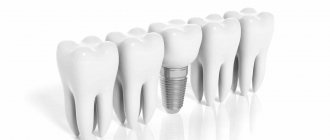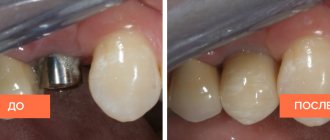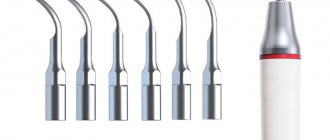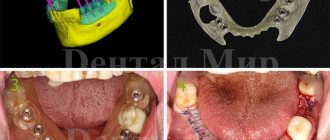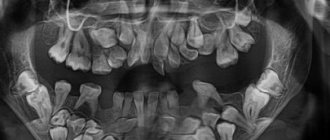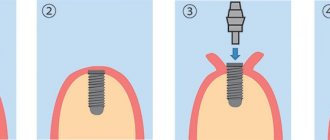The absence of even one tooth is a serious problem, and not only from an aesthetic point of view. After all, it is likely that the chewing load will be distributed unevenly across the remaining teeth, and as a result, the entire dentition will be deformed. In addition, the jaw bone tissues also undergo pathological changes, carious processes are activated, and eventually the remaining teeth may be destroyed. Timely implantation helps to avoid all these troubles.
Why is implantation needed?
The most advanced procedure for restoring teeth today is perhaps implantation.
It is low-traumatic, safe, and allows you to solve the problem in a very short time. The essence of the operation is that a special metal, most often titanium, pin is installed in the patient’s jaw, which will serve as the root of an artificial tooth. Then an abutment is placed on this pin - an intermediate part on which the crown is attached. It is quite possible to install implants immediately after tooth extraction or loss. Its main advantage, compared to conventional prosthetics, is that when installing implants, it is not necessary to grind down adjacent teeth and perform pulp removal. Implantation restores the function of the teeth and jaw and eliminates the risk of bone tissue degeneration.
Possibilities of dental prosthetics using implants Dental prosthetics using an implant will help restore the aesthetics of the smile, as well as the functionality of the jaw. More details THERE ARE CONTRAINDICATIONS. YOU MUST CONSULT A SPECIALIST
In addition, implants help distribute the load evenly across all areas of the jaw, preventing deformation and complications such as pain, malocclusion, and changes in facial proportions.
New Year's discounts! From November 15 to December 31, 2022, reduction in prices for dental prosthetics using implants. View prices THERE ARE CONTRAINDICATIONS. YOU MUST CONSULT A SPECIALIST
Unlike a removable denture, the implant does not need to be removed periodically for cleaning. The owner needs only regular teeth cleaning.
As for the aesthetic side of the issue, crowns cannot be distinguished from your own teeth, since when creating them, specialists take into account the shape, shade and structural features of the patient’s teeth. And, what is especially important for young patients, the implants do not fall out of the mouth when talking or sneezing, since the artificial root is securely implanted into the jaw bone tissue. When chewing and talking, the implants are practically not felt.
Free consultation You can get expert advice, determine a treatment plan and find out the cost at a free initial consultation with a specialist. Sign up THERE ARE CONTRAINDICATIONS. YOU MUST CONSULT A SPECIALIST
Indications for implantation
Indications for implantation, in addition to the absence of one or more teeth, are complete edentia, tooth mobility, periodontal disease, terminal defects of the jaw, increased wear of teeth, open bite.
Contraindications to implantation
However, with all the advantages, implantation also has some absolute contraindications, in which the procedure becomes impossible:
- blood diseases;
- pregnancy;
- severe mental disorders that make communication between doctor and patient problematic;
- individual intolerance to some painkillers;
- malignant tumors;
- connective tissue pathologies.
If previously the list of contraindications to implantation also included diabetes mellitus, hepatitis, periodontal disease and HIV, then thanks to the latest techniques, today there are practically no restrictions for patients with such diseases.
Contraindications Modern implantation has a small list of contraindications and can be performed even with diseases such as periodontal disease, diabetes, HIV, etc. Find out more THERE ARE CONTRAINDICATIONS. YOU MUST CONSULT A SPECIALIST
What is the difference between implantation and prosthetics?
Installing an implant is the most modern and convenient method of restoring missing teeth. However, this is not the only method. Other restoration methods are fixed bridge prosthetics, partial and complete removable dentures. When choosing between dental implantation and prosthetics, it is important to understand that:
- Partial dentures are attached to adjacent teeth with retainers. This is not expensive, but not a very aesthetic and functional method.
- Full dentures are artificial teeth attached to an acrylic base that looks like gums. This orthopedic design covers the gums and palate. This type of denture can cause damage to the lining of the mouth, pain and, as with partial dentures, receding gums and bone loss.
- Bridges installed on supporting teeth need to be replaced after 5-10 years. The teeth on which the bridge is attached wear down and weaken over time. They are also more susceptible to tooth decay. The service life of dental implants is from 20 to 35 years or more (many products come with a lifetime warranty). Installation of dental implants does not require intervention in the structure of healthy teeth, and the implant permanently fuses with the bone, creating a stable base for crowns. Titanium dental implants are resistant to acids produced by bacteria in the mouth that cause decay in natural teeth.
Main stages of dental restoration
Despite the fact that there are several ways to install implants, the main steps of these methods remain common.
Preparation for implantation
The doctor must make sure that implantation is advisable, that the implant will take root safely, and that the patient has no contraindications to the procedure. First of all, an examination of the oral cavity is carried out and its sanitation is mandatory. Then the patient undergoes tests, the list of which includes a coagulogram showing blood clotting ability, a test for glucose levels, blood biochemistry, tests for HIV, hepatitis and syphilis, and a general urine test. X-rays of the jaw, computed tomography and orthopantogram are performed to determine the quality of the bone and the presence of possible pathologies.
Implant installation
If necessary, bone tissue is built up before this stage, since implantation itself is only possible if there is a sufficient volume of it. Augmentation can be performed in a variety of ways, including bone block grafting, guided regeneration, and sinus lift. After preparing the oral cavity, the immediate installation of the implant is carried out, which lasts a relatively short time.
Installation of abutment and healing abutment in case of classical implantation
To achieve a natural contour of the gum tissue around the future tooth, the doctor installs a gum former three to six months after implantation (only with the classic two-stage implantation protocol). After about two weeks, an abutment is attached to the implant.
Crown installation
With one-stage implantation, this procedure is performed within three to four days after implantation. Crowns are always made based on impressions of the patient's jaw so that the new teeth can fully perform the functions of natural ones. Crowns are placed on the abutment using a special adhesive material.
Rehabilitation
During this stage, the patient must periodically visit the doctor to monitor the condition of the implant, as well as carefully care for the oral cavity.
The duration of rehabilitation depends on the method of implantation and the characteristics of the patient’s body. The final chord of the entire procedure is x-rays, on which, if the operation is successful, the doctor will see the complete engraftment of the implant.
Dental restoration Dental prosthetics using an implant can be used to restore one or more teeth. Learn more THERE ARE CONTRAINDICATIONS. YOU MUST CONSULT A SPECIALIST
Types of implants
Implants include single-phase and two-phase products.
- In the first case, the procedure for installing a dental implant lasts about an hour and the aesthetic effect is achieved immediately, since the single-phase implant is suitable for immediate loading and is covered with a temporary prosthesis. This option is especially recommended for the front teeth.
- Biphasic implants are installed in two stages. First, install the implant itself, which replaces the root of the missing tooth. A crown is placed on a tooth only after the wound has healed (after several months).
What is included in turnkey dental implantation?
Some dental clinics offer turnkey implantation. Is this really beneficial and convenient for the patient and what exactly is included in this service?
Let’s imagine a situation: a client came to the clinic for a consultation and received information about the cost of the service. He was completely satisfied with this cost, and he decided to undergo implantation. However, during the course of treatment, he learns that the figures announced are only the price of the implant itself, and it does not include additional manipulations, which, it turns out, are impossible to do without. The client ends up having to pay an amount that is not at all what he was prepared to pay after the initial consultation.
In the case of turnkey implantation, the patient initially receives information about the cost of each service and can make a conclusion about the availability of treatment based on objective figures, since the total amount will not change during the operation.
The cost of turnkey implantation usually includes the following:
- initial consultation with an orthopedist and implantologist;
- comprehensive examination;
- selection of an implantation system and its installation;
- control during the rehabilitation period with x-rays;
- installation of a temporary orthopedic structure if an immediate loading protocol is selected;
- visits to the clinic within a year after the procedure to monitor the condition of the implant.
The total cost also includes anesthesia, the work of the doctor and nurses, and a guarantee of the quality of the implant.
How much does dental implantation cost? The cost of dental services may be influenced by the chosen method of tooth restoration and materials. Find out the cost THERE ARE CONTRAINDICATIONS. YOU MUST CONSULT A SPECIALIST
Implantation methods
In the dentistry of the ILATAN network, dental implantation is carried out in various ways, depending on the characteristics of the clinical picture. At the initial stage - a thorough diagnosis, including x-ray examination, panoramic imaging, blood tests, as well as determining the implantation protocol and developing a plan.
- Classical implantation This is a delayed loading protocol. That is, a permanent prosthesis is installed after the metal implant has completely fused with the bone. If, based on the diagnostic results, the doctor notes a lack of bone tissue, then before implantation, artificial bone tissue is grafted. Classic implant installation is performed under local anesthesia and takes about half an hour. After implantation, the wound is sutured. The stitches are removed after 7-10 days. Permanent prosthetics are performed after 2-3 months on the lower jaw, 5-6 months on the upper jaw.
- Single-phase implantation This is a gentle implantation protocol. The installation of implants is carried out without incisions and does not require sutures. Under local anesthesia, single-phase implants are installed through thin punctures in the gum. Immediately after implantation, temporary metal-plastic prostheses are installed on them. Permanent prosthetics are possible after 9-12 months.
- Prosthetics on implants “All-on-4” and “All-on-6” This is a method of restoring teeth with complete or significant absence. The doctor installs 4 or 6 implants in the jaw, and a complete prosthesis of 10-12 artificial teeth is installed on them. The ability to install implants at an angle allows you to avoid replanting bone tissue in case of its deficiency. This is the fastest and most effective way to restore all edentulous teeth.
Treatment protocols
Initially, there was only one implantation protocol - a two-stage one, requiring a long time for implant installation. However, in recent years, more modern protocols have been developed that allow the patient to get new teeth very quickly.
One-shot protocol
Implantation according to this protocol is the installation of a titanium monoblock implant using a compression method through a small hole in the jawbone. This eliminates major surgical intervention, which means healing is accelerated. Usually performed after the removal of a problematic tooth.
This protocol is used even if the patient is missing more than three teeth, and even with complete edentia. The only limitation is that the patient must have a sufficient amount of bone tissue, since if there is a lack of it, a gentle method cannot be applied.
The main difference between the one-stage protocol is that immediately after the implant is implanted, the patient is given a temporary crown, so that the person will not suffer from a missing tooth for several months, as with a two-stage protocol. After complete implantation of the implant, a permanent crown or prosthesis is attached to it, the material of which is chosen by the patient in advance.
The treatment period takes three to four days, and complete healing takes up to approximately two weeks. The main advantage of the protocol is low trauma, since there is no need for repeated surgery to fix the abutment and install the prosthesis. In addition, the patient returns to an active lifestyle faster, which is especially important for young people.
Basal implantation
If the patient’s bone tissue is significantly atrophied and conventional one-stage implantation is impossible, one-stage basal implantation is performed.
With this method, the titanium implant is installed not in the area of the alveolar process, as with the two-phase protocol, but in the deeper basal layers of the bone. That is why the method is applicable for patients with significant bone tissue deficiency without the need for bone augmentation procedures. Basal implantation is minimally invasive, since a full surgical tissue incision is not made, and the implant is inserted through a small-diameter puncture.
With this method, it is possible to install implants “at an angle” in those places where bone tissue density is higher, which gives greater fixation strength. Since monoblock implants are also used in basal implantation, they are immediately loaded with crowns, so that the patient does not experience aesthetic inconvenience due to the absence of a tooth, and can also chew fully.
Basal implantation has proven itself especially well in cases where a person is missing several teeth in one row, there is complete edentia, or a lot of time has passed since the loss of teeth. If it is necessary to insert one tooth, the doctor may recommend other protocols, since the proximity of “living” teeth to the implant may interfere with implantation “at an angle.”
The treatment period for basal implantation is also short - from three to four days. Complete healing occurs in approximately two weeks.
Based on one-step protocols, modern fixed dentures are manufactured using the All-on-4 system, when the entire structure of the prosthesis is attached to four implants implanted in the jaw.
Two-step protocol
This is a classic of implantation; this is where all modern implantology began. The difference between this protocol and the one-step protocol is that it is carried out in two steps, separated by a significant time interval.
Two-phase implantation is indicated in almost all cases of missing teeth - from one to the entire row of teeth. It is distinguished by its reliability and predictability of the final result. In addition, by suturing the wound after implantation, the likelihood of infection getting into it is eliminated.
The procedure is as follows. At the first stage, an implant is implanted into the patient’s jaw through an incision, after which the patient, while waiting for the implant to fully engraft, lives for quite a long time practically without a tooth.
At the second stage, the gum at the installation site is again opened to fix the abutment, and the necessary procedures are performed to form the gum contour. After some time, the crown is attached to the abutment.
On a note
The two-stage protocol is carried out only if there is a sufficient amount of bone tissue! If there is a deficiency, osteoplasty or sinus lifting is performed before implantation to build it up.
The main disadvantage of the two-phase protocol is that it takes too long. Depending on the condition of the bone tissue and on which jaw the manipulation was performed on, the total duration of the protocol can be about a year. In addition, this method is the most invasive: the gums are cut and sutured.
Implantation stages
Dental implantation is carried out according to the following algorithm:
- Preparation A general diagnosis is very important when planning dental implants. We need to know as much as possible about the patient and know his general condition and dental features in order to be able to decide on the introduction of specific treatment. Therefore, at the very beginning, the implantologist may prescribe general examinations, such as blood tests and specialist consultations. An X-ray examination and panoramic image allows you to determine the thickness and height of bone tissue, structure and density. You can immediately select the type and parameters of the implant, as well as the direction and depth of its insertion.
- Implantation The procedure takes place under local anesthesia and is absolutely painless. In terms of time, depending on the number of dental implants being implanted, their installation can take from 30 minutes to 1.5 hours. After the operation, the implantologist gives detailed recommendations for care and schedules follow-up appointments.
- Prosthetics When the implant has taken root, a gum former is installed to correct the overgrown mucosa. Then, the abutment is the basis for the future prosthesis. An orthopedic doctor takes impressions from which a crown or bridge is made. After trying on the orthopedic design, permanent prosthetics are installed.
- Bone grafting (optional) The quality of the bone is critical to the ability to place a dental implant and stabilize it. This is because the implant surface must be surrounded on all sides by cancellous bone structure for proper integration with the bone. It is important that it be spongy bone, since dense bone structures make it difficult to install a dental implant, and on the other hand, do not provide optimal osseointegration. The bone grafting procedure involves inserting a bone substitute to replace the missing bone material. This provides space for the implant and restores bone structure. In addition, it significantly improves the healing conditions of the implant and the aesthetics of the gums and gingival margin.
Turnkey implantation: price issue
How much will a turnkey implantation cost? This depends, first of all, on the implantation protocol, on the manufacturer of the prostheses, and on the materials used to make the crowns (see Table 1).
Table 1. Average prices for dental implantation
Service
price, rub.
Installation of one classic implant on a turnkey basis
From 25 000
Installation of one one-stage turnkey implant
From 35 000
One-stage implantation of one jaw (6–10 implants) “turnkey”
From 265,000
One-stage implantation of two jaws (14–20 implants) “turnkey”
From 480,000
Simultaneous implantation of one tooth (with extraction)
From 44 000
Prosthesis (removable) All-on-4 for one jaw “turnkey”
From 173,000
Prosthesis (fixed) All-on-4 for one jaw “turnkey”
From 300,000[1]
Which clinic to choose? When choosing a dental clinic, you should pay attention to the availability of licenses, the qualifications of the staff, as well as the technical equipment and reputation of the organization. Where can I go? THERE ARE CONTRAINDICATIONS. YOU MUST CONSULT A SPECIALIST
In any case, before choosing an implantation method, you should consult a doctor: only a specialist can choose the most suitable method, taking into account the condition of the bone tissue, the number of implants needed and other characteristics of the body. Implantation is still quite an expensive pleasure, and in order for the result to be ideal, it is very important to choose the right clinic.
Why is prolonged absence of teeth harmful?
The absence of even one tooth leads to a number of unfavorable changes. An exception is the eighth teeth (called wisdom teeth or “eights”), which are often removed prophylactically due to lack of space for them or their incorrect position.
Consequences of missing teeth:
- The teeth in a row touch each other, causing the chewing force to be distributed throughout the entire dental arch. The absence of one or more teeth in the arch means that the forces are distributed unevenly - the remaining teeth are overloaded, which can cause their destruction.
- The teeth begin to move towards the gap - unsightly gaps form between the teeth, in which food debris accumulates, which contributes to the development of caries and gingivitis. The bite is disrupted, which can lead to changes in the temporomandibular joints. Headaches and a characteristic cracking sound appear when the jaws close.
- A tooth without a “neighbor” on the opposite side (antagonist) begins to protrude from the socket, the neck is exposed, which becomes very susceptible to caries, and its attachment to the bone weakens.
- Malocclusion causes changes in the contact of opposing teeth - this reduces the efficiency of chewing food and can cause digestive problems.
- Missing teeth causes gradual, inevitable loss of bone tissue, which ultimately leads to changes in facial proportions. The result is sunken cheeks, loose skin, the corners of the mouth are directed downwards, the chin protrudes forward, distorting the profile of the face and reducing the distance between the nose and the front chin. Due to the lack of support for the cheeks and lips and sagging skin around the mouth, characteristic wrinkles appear. A man without teeth looks much older than he actually is.
Why choose dental implantation?
Implantation of a dental implant takes place under local anesthesia, so it is painless and does not last long. This solution undoubtedly has many advantages, one of which is an excellent aesthetic effect. The implant itself is completely invisible, and the crown covering it is very precisely matched to the surrounding teeth, both in shape and color. Implants do not limit us in any way, which may be the case with other types of restorations, such as dentures, crowns or bridges.
We don't have to worry about damaging the implant by eating solid foods because these types of restorations are made from high-quality materials that are extremely durable and resistant to damage. For most patients, a properly integrated dental implant will be a lifelong solution.
Prices for implantation in complete absence of teeth
| Implantation of 1 jaw turnkey | Price* | |
| On 4 implants | Dentium (South Korea) | RUB 223,100 |
| Nobel (Sweden) | 340,000 rub. | |
| Astra (Sweden) | RUB 307,100 | |
| Ostem (South Korea) | 220,000 rub. | |
| On 6 implants | Dentium (South Korea) | RUB 294,000 |
| Nobel (Sweden) | 450,000 rub. | |
| Astra (Sweden) | 420,000 rub. | |
| Ostem (South Korea) | 290,000 rub. | |
| Implantation of 1 jaw turnkey | Price* |
| On 4 implants | |
| Dentium (South Korea) | RUB 223,100 |
| Nobel (Sweden) | 340,000 rub. |
| Astra (Sweden) | RUB 307,100 |
| Ostem (South Korea) | 220,000 rub. |
| On 6 implants | |
| Dentium (South Korea) | RUB 294,000 |
| Nobel (Sweden) | 450,000 rub. |
| Astra (Sweden) | 420,000 rub. |
| Ostem (South Korea) | 290,000 rub. |
Included in cost:
- Diagnostics (initial consultation);
- 3D modeling of implantation;
- Implantation surgery (tooth extraction, installation of 4 or 6 root-shaped implants);
- Anesthesia;
- Taking impressions and making a temporary fixed prosthesis from metal-plastic;
X-ray examination – paid separately.
Attention: at the NovaDent clinic you can pay for dental implantation on credit and complex treatment in installments.
